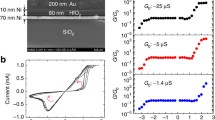Abstract
In this paper, we propose a star-like weakly connected memristive neural network which is organized in such a way that each cell only interacts with the central cells. By using the describing function method and Malkin’s theorem the phase deviation of this dynamical network is obtained. And then, under the Hebbian learning rule the phase deviation is designed as a desired model for associative memory. Moreover, we take the store and recall of digital images as an example to demonstrate the performance of associative memory. The main contribution of this paper is supply a useful mechanism which the new potential circuit element memristor can be used to realize the associative.







Similar content being viewed by others
References
Chua LO (1971) Memristor-the missing circuit element. IEEE Trans Circuits Theory CT–18(5): 507–511
Strukov DB, Snider GS, Stewart DR, Williams RS (2008) The missing memristor found. Nature 453: 80–83
Itoh M, Chua LO (2009) Memristor cellular automata and memristor discrete-time cellular neural networks. Int J Bifurcation Chaos 19:3605–3656
Merrikh-Bayat F, Shouraki SB (2011) Programming of memristor crossbars by using genetic algorithm. Procedia Comput 3:232–237
Corinto F, Ascoli A, Gilli M (2011) Nonlinear dynamics of memristor oscillators. IEEE Trans Circuits Theory I 58:1323–1336. doi:10.1109/TCSI.2097731
Peshin YV, Ventra MD (2008) Spin memristive systems: spinmemory effects in semiconductor spintronics. Phys Rev B 78(11):1–4
Xia Q, Robinett W, Cumbie MW, Banerjee N, Cardinali TJ, Yang JJ, Wu W, Li X, Tong WM, Strukov DB, Snider GS, Medeiros-Ribeiro G, Williams RS, Memristor B (2009) VCMOS hybrid integrated circuits for reconfigurable logic. Nano Lett 9(10):3640–3645. doi:10.1021/nl901874j
Borghettil J, Snider GS, Kuekes PJ, Yang JJ, Stewart DR, Williams RS (2010) Memristive switches enable stateful logic operations via material implication. Nat Lett 464(8):873–876
Yang JJ, Pichkett MD, Li X, Ohlberg DAA, Stewart DR, Williams RS (2008) Memristive switching mechanism foe metal/oxide/metal nanodevices. Nat Nanotechnol 3(7):429–433
Itoh M, Chua LO (2008) Memristor oscillators. Int J Bifurcation Chaos 18:3183–3206
Hu J, Wang J (2010) Global uniform asymptotic stability of memristor-based recurrent neural networks with time delays, in 2010. In: International joint conference on neural networks, IJCNN2010. Spain, Barcelona
Zeng ZG, Wang J (2008) Design and analysis of high-capacity associative memories based on a class of discrete-time recurrent neural networks. IEEE Trans Syst Man Cybern Part B 38(6):1525–1536
Zeng ZG, Huang DS, Wang ZF (2008) Pattern memory analysis based on stability theory of cellular neural networks. Appl Math Model 32(1):112–121
Zeng ZG, Wang J (2007) Analysis and design of associative memories based on recurrent neural networks with linear saturation activation functions and time-varying delays. Neural Comput 19(8):2149–2182
Zeng ZG, Huang DS, Wang ZF (2005) Global stability of a general class of discrete-time recurrent neural networks. Neural Process Lett 22(1):33–47
Zeng ZG, Huang DS, Wang ZF (2004) Attractability and location of equilibrium point of cellular neural networks with time-varying delays. Int J Neural Syst 14(5):337–345
Li HQ, Liao XF, Huang TW (2013). Second-order dynamic consensus of multi-agent systems with arbitrarily fast switching topologies. IEEE Trans Syst Man Cybern. doi:10.1109/TSMC.2013.2242466
Li HQ, Liao XF, Liao RJ (2012) A unified approach to chaos suppressing and inducing in a periodically forced family of nonlinear oscillators. IEEE Trans Circuits Syst I 59(4):784–795
He X, Li CD, Huang T, Li CJ (2013) Codimension two bifurcation in a delayed neural network with unidirectional coupling. Nonlinear Anal 14(2):1191–1202
He X, Li CD, Huang T, Li CJ (2013) Bogdanov-Takens singularity in tri-neuron network with time delay. IEEE Trans Neural Netw Learning Syst. doi:10.1109/TNNLS.2013.2238681
Dong T, Liao XF (2012) Dynamics of congestion control in wireless access networks. Nonlinear Anal Ser B 48:123–132
Dong T, Liao XF (2013) Bogdanov-Takens bifurcation in a tri-neuron BAM neural network model with multiple delays. Nonlinear Dyn 71:583–595
Wang HW, Song QK (2010) State estimation for neural networks with mixed interval time-varying delays. Neurocomputing 73(7):1281–1288
Wang HW, Song QK, Duan C (2010) LMI criteria on exponential stability of BAM neural networks with both time-varying delays and general activation functions. Math Comput Simul 81(4):837–850
Itoh M, Chua LO (2004) Star cellular neural networks for associative memory and dynamic memory. Int J Bifurcation Chaos 14(5):1725–1772
Hoppensteadt FC, Izhikevich M (2000) Pattern recognition via synchronization in phase-locked loop neural networks. IEEE Trans Neural Netw 11(3):734–738
Hoppensteadt FC, Izhikevich EM (1999) Oscillatory neurocomputers with dynamic connectivity. Phys Rev Lett 82(14):2983–2986
Hoppensteadt FC, Izhikevitch EM (1997) Weakly connected neural networks. Springer, New York
Gilli M, Bonnin M, Corinto F (2005) On global dynamic behavior of weakly connected oscillatory networks. Int J Bifurcation Chaos 15:1337–1393
Corinto F, Bonnin M, Gilli M (2007) Weakly connected oscillatory networks for pattern recognition via associative memory and dynamic memories. Int J Bifurcation Chaos
Genesio R, Tesi A (1993) Distortion control of chaotic systems: the Chua’s circuit. J Circuits Syst Comput 3:151–171
Aoyaagi T (1995) Networks or neural oscillators for retrieving phase information. Phys Rev Lett 74: 4075–4078
Acknowledgments
This publication was made possible by NPRP grant # NPRP 4-1162-1-181 from the Qatar National Research Fund (a member of Qatar Foundation). The statements made herein are solely the responsibility of the authors. This work was also supported by Natural Science Foundation of China (grant no: 61374078).
Author information
Authors and Affiliations
Corresponding author
Rights and permissions
About this article
Cite this article
Wang, X., Li, C., Huang, T. et al. A Weakly Connected Memristive Neural Network for Associative Memory. Neural Process Lett 40, 275–288 (2014). https://doi.org/10.1007/s11063-013-9328-3
Published:
Issue Date:
DOI: https://doi.org/10.1007/s11063-013-9328-3




